When millions of people live together in one place, problems are sure to occur.
For examples, problems arise with construction, transportation, and communication and food sources. Through the years, of course, many solutions have been devised and been put in place to relieve the effects of these problems. But none of them has been totally or permanently solved.
Human beings are the only creatures on Earth granted the abilities to think, calculate and draw conclusions. For this reason, it is natural for us to make plans, to have the foresight to build structures to make our lives more comfortable and to apply creative solutions to our various needs. But the fact is, some creatures can do the same things even better than human beings can—which is indeed cause for consideration! These creatures have no intelligence or consciousness and sometimes they do not even have a brain; yet, they erect structures and establish organizations comparable—and in many ways superior—to any that human beings can create. Surely this, too, is food for thought!

| ||
| The differences between the various stages and classes of termites: | ||
| 1. Larva | 3. Soldier | 5. Supplementary reproductive |
Many species in nature have successfully established an organized common life. For example, consider the so-called “social insects”—ants, bees and termites.
But when we compare the ordered lives of termites with that of these other insects, we can see that termites’ social order is more complex than that of bees, and more closely organized than that of ants—and more coordinated and problem-free than most human social systems!
Every activity in the colony, from nest-building to communication and defense, is effected with intelligent calculation and deliberate planning. Such calculated planning is something that comes only with education and knowledge; this tells us that some kind of knowledge has informed and shaped the activities of termites. How have termites come to possess this knowledge that teaches them what to do from the moment they hatch? What is the source of the awareness in their activity? How to explain that such a tiny insect possesses abilities that are thought to belong only to human beings?
Answers to these questions will emerge from the examples that follow, as we examine the lives of termites.
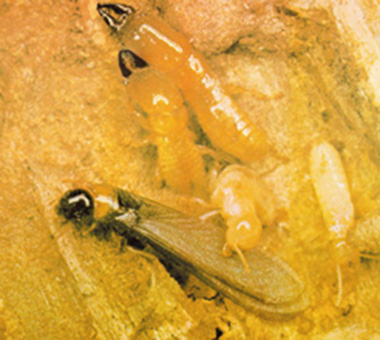 |
| The queen and the king are very important for the colony. The workers pay special attention to the queen. Unlike other members of the colony, the queen and the king have wings; they lose them after mating. |
All the members of any termite colony share one common goal—to perpetuate the nest; and every member carries out its duty flawlessly. Termite colonies are composed of “castes,”—groups that specialize in various activities; and each caste may have more than a million members. Every group is physically different from the others and has its own particular duties to perform.
Termite species are classified into three groups, according to where they live: underground, above ground termites and drywood termites. Each of these groups has a different kind of colony life. If you look into at a termites’ nest, you will see some termites that have different appearances, because each nest is divided into four castes:
◉ The king and queen. : The queen has a different appearance from other members of the colony and she is very important for all of them. The growth of the colony depends on the queen.
◉ Alates or swarmers. : These termites have wings; they are the alates that will later fly off to mate. When they actually become kings and queens, they will lose their wings.
◉ Workers: With their wings and strong jaws, workers form the largest number of termites. Their duties in the colony are to build the nest, find food and tend to the general order of the nest.
◉ Soldiers: Smaller in numbers are the soldiers, whose only duty is to protect the nest.
According to the type of termite, the soldiers have different qualities; some soldiers in some species have a proboscis that secretes a sticky liquid useful in escaping aggressors. Other soldiers have big heads and large jaws; they attack everything that tries to get into the nest.
Now let’s look more closely at the other members of the termite colony.
The alates’ bodies are blackish-brown in color. They have two wings on either side of their bodies, one of the major differences that distinguish them from other members of the colony. Two other characteristics that distinguish the alates are their visual and procreative abilities. Those members that can reproduce develop twice a year, but only at certain seasons of the year.
The alates wait in their own dark chamber until they’re ready to leave the nest. This is important for the security of the colony and to prevent chaos. If there were more than one prospective king or queen in the nest, discipline would break down and confusion would take over in the colony. For this reason, worker termites take ample precautions so that there is only one king and one queen in the nest.
 | 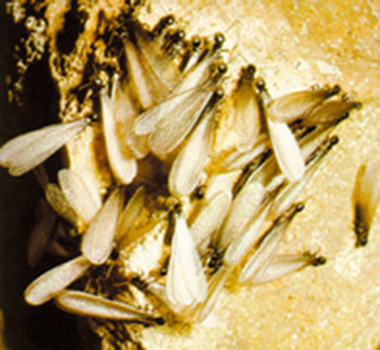 |
| Winged reproductives leave the colony at mating time. The wings are a sign of their strength and will assist them in finding sites for a new colony. | |
One of these precautions involves keeping the alates closed up in their own areas. But when the time comes, the candidates must emerge. They leave the nest by way of special tunnels constructed by the workers, so that they can leave the colony without having to enter the nest and cause confusion. They leave the nest with the first rains, for with rains, the young alates’ wings develop and they can move in the tunnels. Once they fly, some of them may never come back. The alates are weak flyers and can not go more than 500 meters (1,500 feet) from the nest.1 On their first-ever flight, many of them get eaten by birds and reptiles or otherwise lose their way. Those that do manage to survive lose their wings after their flight is over and construct a hidden burrow that will house the colony. When the king and queen mature, they enter a life-long bond, reproducing to found the colony. As with all other operations and processes in a colony, all termites know their duties very well and there is no question of rebellion. The future kings and queens never abandon the nest; they are aware of their responsibilities and do what they need to do to establish new colonies.
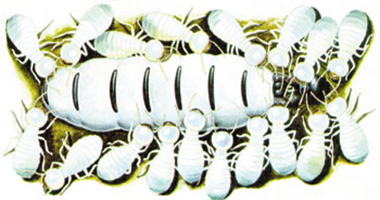 |
The main difference between the queen and other termites is that she has wings. These wings are not permanent, but are a sign of her status. The mature queen begins to establish a colony in the spring; she then leaves the nest in search of a king and in her search, uses fluids called pheromones from her body to attract him. After a short flight, she alights on the ground, raises her body and emits a secretion from her glands. From one gland on her back, she secretes a fluid that can attract a king from a distance of 20 cm (7 inches), from her thorax, she secretes another pheromone that’s effective up to a distance of 3 cm (1.1 inches).
After the king and queen have come together, they go in search of a place where they can mate. The dig a tunnel, dig a mating chamber and later begin to construct a nest. The queen first lays 5 eggs; the first termites that hatch from these eggs are nurtured by the king and queen to be workers.2
The queen has an incredible reproductive capacity. One species of termite (an African species, Macrotermes natalensis) whose queen lays 30 thousand eggs each day;3 that is, one every three seconds. Even an old queen can lay egg the same rate. A queen may live to be between 25 and 30 years, producing tens of millions of eggs in her life.
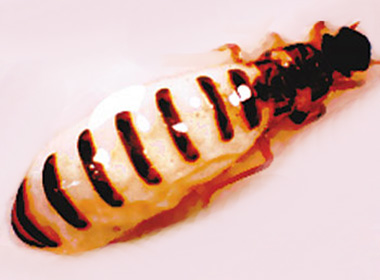 | 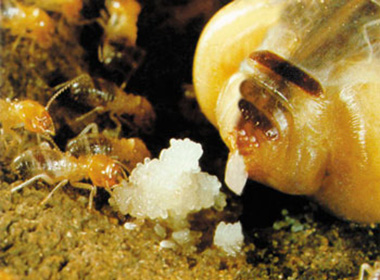 |
| At first, the queen resembles any other termite, but gradually she will become huge, growing so large that she cannot move, and the workers will be responsible for caring for her. It is God that informs the workers of the queen's needs and teaches them how to supply them. | |
As with a colony of bees and ants, it is the queen that ensures order and continuity. There is a queen in the center of every termite colony. The king and queen live in a special room in the nest where they are looked after by the workers. This room, the heart of the colony, is the most vulnerable place in the nest and therefore, the best protected. The queen has grown too large to move; when she began laying eggs, her body hugely enlarged up to 14 cm (5.5 inches) long and 3.5 cm (1.4 inches) across.4 Since she is unable to feed herself, other members of the colony take care of her. The workers responsible for feeding the queen satisfy her needs unfailingly, always at the right time.
Even though she cannot move, the queen keeps tight control over her nest’s order, security and the many needs. In the following chapters, we’ll examine exactly how the queen is able to do this by herself.
 |
| This 1- to 2-cm (0.3- to 0.7- inch) creature pictured here does all the work in a termite colony. |
Although the queen doesn’t communicate directly with the other termites, she knows what her nest requires. Even her body has attained a length of 10 cm (5.5. inches) and she must lie motionless throughout the egg-laying period, she knows the needs of the nest; she is aware if there is any confusion and what class of termite is needed to remedy it.
How can she remain aware of such an extraordinary trove of information? This is a clear proof of the faultless and flawless functioning of a system created by God.
As stated earlier, the queen is fed by the workers, and during this feeding, what is happening in the colony is transmitted to her uninterruptedly. The workers give her this information through secretions. All termites produce secretions on their bodies, by which the queen is informed of the state of the colony. When a worker is feeding her, the queen becomes aware of the needs of the colony. For example, if a soldier is killed in an attack, the queen receives news of it through chemicals secreted by the worker feeding her.
If many soldiers have been lost, as a first precaution the queen secretes a compound that causes young termites to develop into soldiers, which chemical is delivered to the young termites by the workers. In this way, it is determined to what caste the young termites will belong.
It is necessary to analyze a fluid in order to determine what it contains and to do so, a laboratory is required. Instruments used for the analysis must be able to detect the contents of the fluid; and of course, those doing the analysis must be trained in the field and have the requisite knowledge. The queen termite analyzes the fluids in a very short time and does so throughout her whole life. She secretes the fluid appropriate to particular needs, ensuring the proper organization for the survival of her colony’s hundreds of thousands of termites. The termites carrying the substance secreted by the queen know what they must do because they can perceive the code hidden in the secretion and recognize its significance. Therefore, all other termites in the colony have the same ability to analyze.
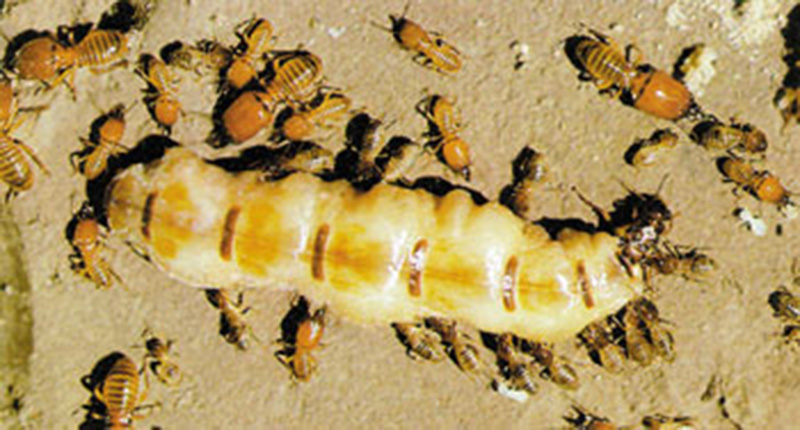 |
| In the picture is the queen termite surrounded by workers. The queen continually lays eggs while being fed by the workers. In this feeding relationship, the workers keep the queen informed about what is going in the nest. |
This is one of the wonders of a termite colony. In the colonies, it is not clear from the moment of their birth what caste the individuals will belong to and what kind of work they will do. At birth all the larvae are undifferentiated. The larvae’s future duties and responsibilities will be determined by the present needs of the colony, according to which the queen secretes a substance which the workers deliver to the larvae.5
Clearly, the queen cannot determine what individuals her colony requires. For what seems to be thought, judgment and decision making on the part of the queen, there is only one explanation: Her activities must be under the control of some power. The queen’s supervision of the nest is under God’s inspiration. It is He Who teaches every living creature on Earth how they are to behave.
And in your creation and all the creatures He has spread about there are Signs for people with certainty. (Surat al-Jathiyya:4)
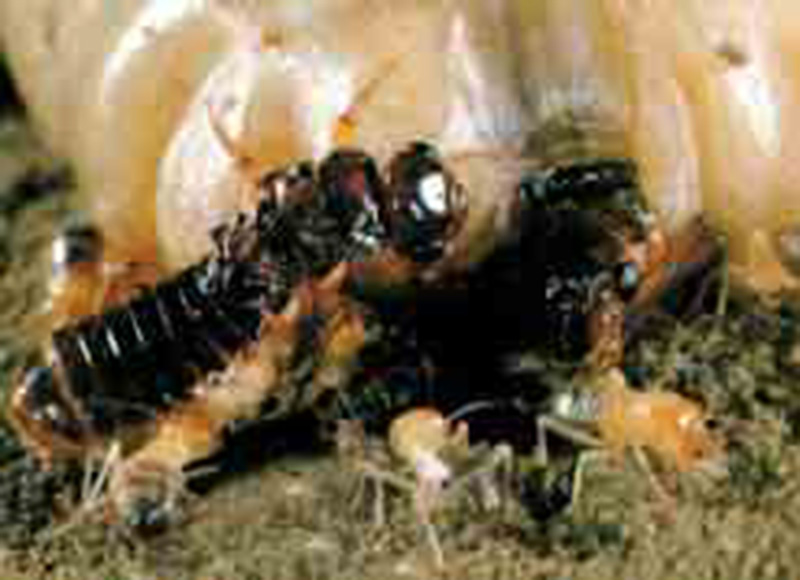 |
| The king termite (the dark one pictured on the left) is larger than other members of the colony and is always at the queen's side. The worker termites provide everything needed to care for the king and the queen. |
The workers that care for the nest are infertile, blind and wingless. Soft-bodied and cream-colored, they reach adolescence in one year, with a lifespan of between 3 and 5 years.
Except from egg-laying and defending the nest, worker termites do all the other chores; they construct the tunnels and chambers, expanding and repairing them when necessary. Until they come of age, as larvae they need to be cared for. The queen, equally unable to supply her own needs, must also be looked after. Again, the workers tend to all this. Some species of termites feed on fungus, which the workers grow right there in the nest. So workers also serve as the farmers of the colony and, in short, provide for all their colony’s daily needs.6
 | There are countless workers in a termite nest. On the left can be seen workers tending the larvae; on the right, workers are raising fungus. Worker termites build and repair the nest, care for and protect the eggs, young termites and the queen, making sure they all have enough food. |
 |
That the workers laboring endlessly are infertile is a problem for evolutionists because—as we shall show in the following chapters—self-sacrifice on the part of the workers is the foundation of the order in the nest. Barren termites, living only to work for the other members of the nest, pose a big problem indeed for the evolutionists’ claim that nature is a battleground.
| 1. Antenna | 4. Maxilla | 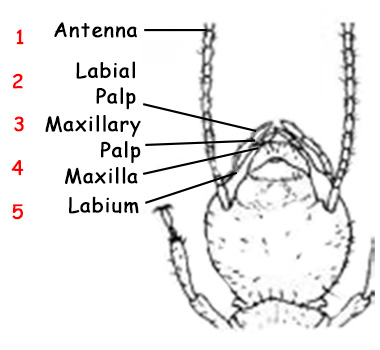 |
| Here we see in detail a worker termite's head. Its antennae are necessary for communication, just as the special mouthparts are needed to feed members of the colony. No intelligent person would ever think that this intricate design could come into being by itself. | ||
Charles Darwin admitted that such complex behavior in some creatures is “by far the most special difficulty which my theory has encountered.”7
Why is the activity of social insects “the most special difficulty” for the theory of evolution? To explain, we must examine the illogicality of the evolutionists’ claims—an illogicality that they themselves often admit.
Evolutionists claim that complex behavior such as termites display has come about through the mechanism of natural selection. This amounts to the supposition that creatures learn certain behavior through experience. When, in time, this behavior proves to be good and advantageous for the species, it becomes adopted through the mechanism of natural selection. Later on, this same advantageous behavior is inherited by later generations.
The following considerations show why these claims are untenable:
First of all, the behavior that many species display cannot be attributed to experience. For example, the first thing a newly-hatched cuckoo does, even before it can open its eyes, is to push the other eggs out of the nest. Certainly this behavior cannot be learned; when the cuckoo bird hatches, it perceives no other creature in its vicinity, but it already knows what to do with the other eggs. In other words, the cuckoo had this knowledge even before it was born.
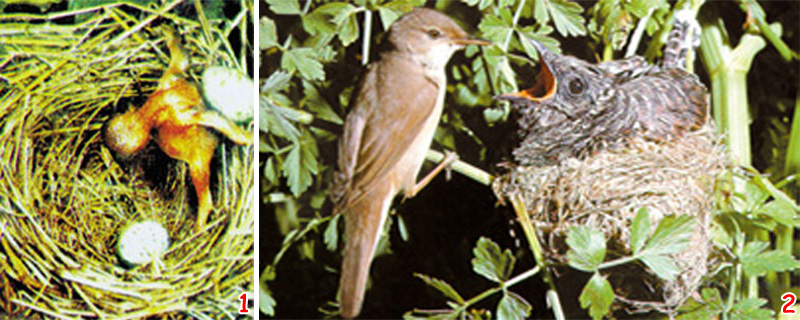 |
| 1. The cuckoo lays its eggs in another bird's nest. As soon as the chick hatches, the first thing it does is push the other bird's eggs out of the nest. |
Even if we suppose that a bird learned this behavior through experience, there would be no genetic possibility of one’s passing it on to subsequent generations. The acquired abilities would belong only to that creature. Just as the child of a trained surgeon could not become a doctor without being trained himself, learned behavior cannot be passed on genetically to a creature’s offspring. Considering this, we can see how untenable and unscientific evolutionist claims truly are.
Termites Prove Darwin Wrong |
| Unlike nearly all other insects, termites have front and back wings that are identical. The only exception is the Mastotermes darwiniensis, or "Darwin's termite." The hind wings of this species have a distinct "anal lobe" that resembles the one visible in cockroaches and praying mantises when they unfold their hind wings. When this was first discovered in these termites, evolutionists were excited because they thought that the anal lobe was proof that termites evolved from cockroaches. But when we examine this structure, which is presented as if it was a proof for evolution, we see that all these similarities do not prove evolution at all. On the contrary, they are evidence of creation. The Darwin's termite cannot have been a "primitive ancestor" because their colonies are among the most populous of the social termites. Therefore, evolutionists might characterize them as highly evolved. Of course, saying that they possess highly evolved characteristics and also are a "primitive ancestor" is a serious contradiction, from the point of view of evolution. And unlike cockroaches, but like other termites, these shed their wings at preformed breakage points. Unlike cockroaches and mantises, when the hind wings are at rest, the anal lobe is not folded up in a fan-like manner; but is bent over flat on the rest of the wing. From these examples, we can see that it is very difficult to establish a clear similarity between termites on the one hand and cockroaches and mantises on the other. So, what does the fossil record show? The photograph shows Dominican amber calculated to be 35 million years old, with a winged Mastotermes electrodominicus which has all the main characteristics of modern Australian termites (such as anal lobes and five segments in the feet). In other words, the first Mastotermes was the same as the modern Darwin's termite. And the same amber specimen contains termite species with those features that evolutionists call "modern." All this shows that termites did not evolve from any creature but, like all other creatures, were created by God. (Joachim Scheven, "Darwin's Termite," Creation, March-May 1996, p. 24.) There is another important consideration: Behavior patterns of the workers assigned to do almost everything in a termite nest require collecting information, calculation, planning ability and judgment. These behaviors cannot be inherited because the workers are infertile! They cannot pass on their characteristics genetically. So even if we suppose that a worker termite can learn the behavior appropriate to it—which is impossible—the worker still couldn’t pass it on to the next generation because it cannot produce any new generation. Among social insects, only the queen has the ability to reproduce and pass on her genes to the generation after her. But her features are not sufficient to perpetuate the colony’s existence. It could not survive without the cooperation, discipline and self-sacrifice of the workers and the soldiers. As soon as they hatch, these tiny insects know very well what they have to do. Who, then, teaches them how to carry out their activities? |
 |
| 1. Darwin's termites |
These are questions still awaiting answers from evolutionists. Charles Darwin was well aware of the problems; in his On the Origin of Species, he admitted the difficulties that the behavior of social insects posed to his theory:
If a working ant or other neuter insect had been an ordinary animal, I should have unhesitatingly assumed that all its characters had been slowly acquired through natural selection; namely, by individuals having been born with slight profitable modifications, which were inherited by the offspring, and that these again varied and again were selected, and so onwards. But with the working ant we have an insect differing greatly from its parents, yet absolutely sterile; so that it could never have transmitted successively acquired modifications of structure or instinct to its progeny. It may well be asked how it is possible to reconcile this case with the theory of natural selection?8
As with the ants that Darwin mentions in the above quotation, so it is with termites: all the workers are infertile. Evolutionists cannot explain this phenomenon.
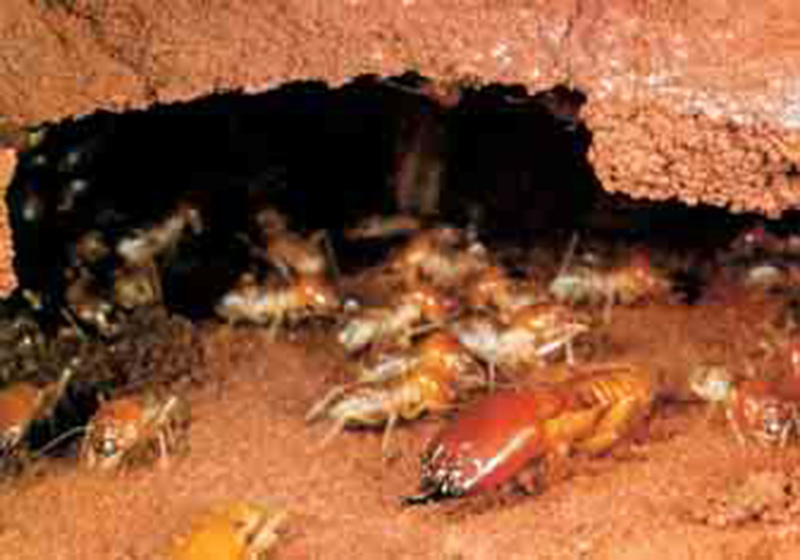 |
| In the picture, workers repairing the nest while being protected by soldiers. This mutual assistance among creatures living together shows one of the many ways in which the evolutionists' claims are untenable. |
It’s of course possible for an infertile creature to develop certain characteristics, learn useful behavior patterns and acquire experience in the course of its life—but this is of no value for the theory of evolution. Dr. Ali Demirsoy, an evolutionist professor, comments on this matter:
. . . As we said earlier, the fact that an individual may survive successfully does not say very much from the evolutionary point of view. The important thing is to produce many offspring thereby contributing genes to the gene pool. No matter how long an individual lives, if they [sic] do not produce offspring, they are unimportant from the point of view of evolution. For this reason, the death of these individuals is called “genetic death.”9
“Genetic death” means the end of the generation of that creature. But worker termites have survived millions of years without changes and have been able to perpetuate their existence even though they are barren. These facts belie all the claims put forward by evolutionists.
Our previous examples showed that the behavior of termites, ants, bees and other creatures that live communally cannot be explained by any such distorted evolutionary mechanism as natural selection. There is only one explanation: God, with His infinite power and knowledge, has created every living creature on the face of the Earth.
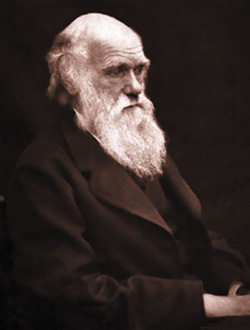 |
| Charles Darwin |
Every member of a termite colony knows what task it must do and performs it flawlessly. Because these insects display no selfishness, they live in a perfectly ordered colony.
A similarly peaceful order, found in all social insects, is worth careful consideration. We have spoken about the importance of the self-sacrifice of termites in the maintenance of a stable order in their nests.
It is often to be noticed in the behavior of creatures that they are willing to put their own lives in danger for the sake of their offspring or another without considering their own needs. There are so many examples of this kind of behavior that evolutionist scientists are forced to admit it.
For example, the evolutionist Peter Kropotkin wrote about solidarity among animals in a book entitled Mutual Aid: A Factor in Evolution, showing how successful ants and termites were as a result of their helping one another:
Their [tThe ants’ and termites’] wonderful nests, their buildings, superior in relative size to those of man; their paved roads and overground vaulted galleries; their spacious halls and granaries; their corn-fields, harvesting and "malting" of grain; their rational methods of nursing their eggs and larvae . . . and, finally, their courage, pluck, and superior intelligence—all these are the natural outcome of the mutual aid which they practice at every stage of their busy and laborious lives.10
Note that this evolutionist writer speaks of “mutual aid.” This is the behavior of a blind insect a few centimeters long without the capacity for thought. It is natural for human beings to help one another, devise plans together, put them into effect and to develop new systems and technology to make life easier; but it cannot be considered natural for insects to do this. If a creature with no capacity for thought shows intelligence, it means that some power is directing it; that a force drives it to devise intelligent plans and sacrifice itself for others.
That power is God’s infinite intelligence and might.
1 “Isoptera;” http//info.e.ac.uk/~gjlramel/isoptera.html 
2 Christopher O'Toole, The Encylopedia of Insects, New York: Facts On File Publications, 1986, p. 35. 
3 Denis Crawford, “An Eggsellent Adventure;” http://www.csiro.au/helix/thehelix/pastissues/Th101Insecteggs.pdf; Karl Von Frish, Animal Architecture, New York: Harcourt Brace, p. 124. 
4 Christopher O'Toole, The Encyclopedia of Insects, New York: Facts On File Publications, 1986, p. 35. 
5 “Termites;” http://oldsci.eiu.edu/physics/Ddavis/fam/Insects/Termites.html 
6 Karl Von Frish, Animal Architecture, New York: Harcourt Brace, p. 137. 
7 Charles Darwin, The Origin of Species, Chapter VIII., “Instinct.” 
8 Charles Darwin, The Origin of Species, Chapter VIII., “Instinct.” 
9 Prof.Ali Demirsoy, Yasamin Temel Kurallari Genel Biyoloji/Genel Zooloji (Fundamental Laws of Life, General Biology / General Zoology), vol. I, Ankara, 1993, p. 605. 
10 Peter Kropotkin, Mutual Aid: A Factor of Evolution, Chapter 1. 